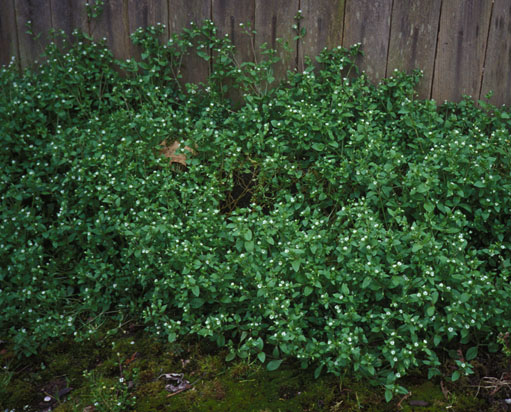
|
| Chickweed; Stellaria media (L.) Vill. |
Pink Family; CARYOPHYLLACEÆ
|
| Chickweed is a stringy, little, soft, weak, colony-forming, annual herb. Its bears tiny white flowers. From Eurasia, it is now
common as dirt in most of the temperate world. It scarcely cares about sunshine or shade, nor cold, but hates heat, dryness, and hard-packed
ground. Moist, rich, disturbed soil pleases it, allowing lush, exuberant growth. A Chinese name, Fan Lü, translates "A tangle of Thread" --an
apt description. Other English names include: Satin-flower, Starwort, Starweed, Winterweed, Birdweed, White Bird's-Eye, Chicken's
Meat, and Mischievous Jack. The only common weed strongly resembling it is Scarlet Pimpernel
(Anagallis arvensis), also called fittingly
Red Chickweed. |
| Gardeners need not worry about Chickweed, unless its mat-like sprawling offends their sense of æsthetics, since it's probably
more valuable as a groundcover or green manure, than harmful as a crop competitor. Getting rid of it is difficult besides it reseeds so
quickly. The shallow roots are easily yanked up, however. |
| It is much esteemed as a wild edible plant for three solid reasons: year-round availability, great abundance, and mild enough in
flavor to be the single best lettuce-like wild substitute for mixed salads. If raw Chickweed is found unappetizing, try cooking it. |
Some of its woodland-wildflower, and lawn-weed cousins, are inedible due to furriness or stringiness. Mouse-ear
Chickweeds (Cerastium spp.) are in this category. Only by being adapted to disturbed, rich soils, does Chickweed develop the happy qualities
making for an excellent edible. In the Language of Flowers, it means "Rendezvous" or "Render Yourself."
|
Originally published as the Seattle Tilth newsletter Weed of the Month in February 1986, along with an illustration drawn by Jerri Geer.
Back |
|
|

